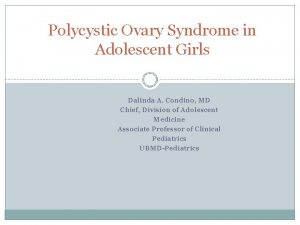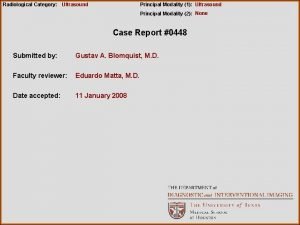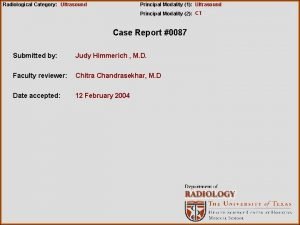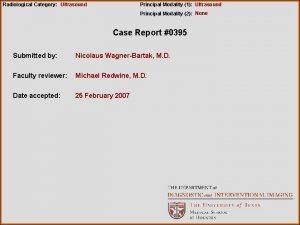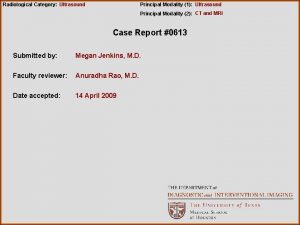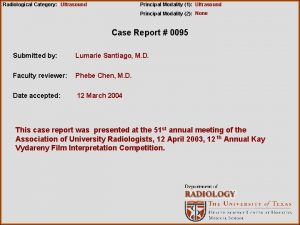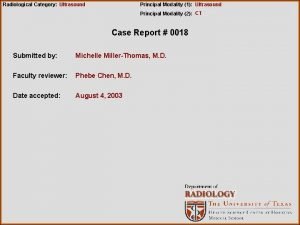Radiological Category Ultrasound Principal Modality 1 Ultrasound Principal








- Slides: 8

Radiological Category: Ultrasound Principal Modality (1): Ultrasound Principal Modality (2): None Case Report #0493 Submitted by: Paul D. Bertolino, M. D. Faculty reviewer: Michael Redwine, M. D. Date accepted: 10 March 2008

Case History A twenty-seven year old pregnant woman presents with vaginal bleeding.

Radiological Presentations

Test Your Diagnosis Which one of the following is your choice for the appropriate diagnosis? After your selection, go to next page. • Retroplacental hemorrhage • Contraction of the myometrium • Uterine fibroid

Findings and Differentials Findings: A single intrauterine pregnancy is identified. There is also a 4 x 4 cm poorly marginated isoechoic mass-like lesion in the subchorionic myometrium. Differentials: • Retroplacental hemorrhage • Contraction of the myometrium • Uterine fibroid

Discussion Pregnant patients presenting with vaginal bleeding are often evaluated with ultrasound. High morbidity and mortality are associated with placenta previa and abruptio placenta, thus prompt sonographic evaluation is essential. Abruptio placenta is associated with retroplacental hemorrhage (RPH), which may be identified with ultrasound. The echogenicity of RPH depends on the age of the hematoma, but if large enough may be biconcave and impress upon the chorionic plate. Small hematomas may not be visualized with US. As an associated sign of RPH, the placenta may become thickened. Should the RPH dissect into the placenta or amniotic cavity, linear, well-demarcated anechoic areas may be seen in the placenta. Uterine fibroids may be seen adjacent to the placenta and present as a retroplacental mass-like lesion. Fibroids contribute to an increased risk of pregnancy loss, and ultrasound with Doppler imaging can be helpful in diagnosis. Typically, fibroids present as well-circumscribed, solid, hypoechoic masses that may have calcifications or may demonstrate heterogeneous areas indicating degeneration. They may attenuate the US beam or have mass effect upon the serosal or endometrial contour. Fibroids are usually hypovascular and hypercellular when compared to the myometrium. Evaluation using color Doppler can help differentiate fibroids from myometrial contraction. Typically, vessels are splayed around the periphery of a fibroid given the relative hypovascular composition. In the event of the rare hypervascular fibroid, vessels may be seen within the fibroid, but will also be seen splayed around the periphery.

Discussion Myometrial contractions are transient findings that resolve on delayed scanning. They present as a homogeneous isoechoic mass without acoustic attenuation. They may distort the endometrial surface, but usually do not impress upon the serosal surface. Rescanning the patient after approximately thirty minutes will likely show resolution of the contraction. Differentiation between uterine fibroids and contractions can also be done with color Doppler imaging. As opposed to the splaying of the vessels in a fibroid, vessels can be seen coursing through a uterine contraction. This image obtained approximately thirty minutes following the first image in approximately the same plane demonstrates that the mass-like lesion has resolved.

Diagnosis Contraction of the myometrium. 1. John Mc. Gahan, Harold Phillips, Michael Reid, Richard Oi. Sonographic Spectrum of Retroplacental Hemorrhage. Radiology. 1982 142: 481 -485. 2. Ada Kessler, Donald Mitchell, Kathleen Kuhlman, Barry Goldberg. Myoma vs. Contraction in Pregnancy: Differentiation with Color Doppler Imaging. Journal of Clinical Ultrasound. 1993 21: 241 -244.
